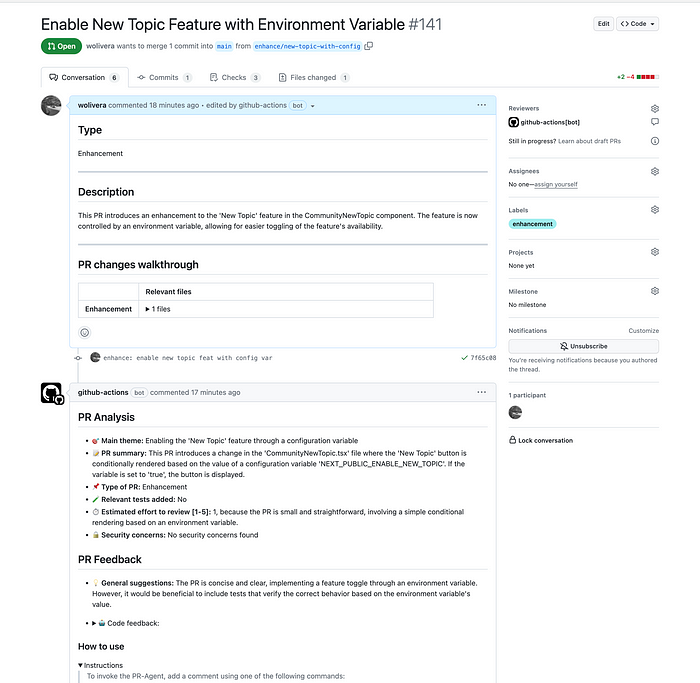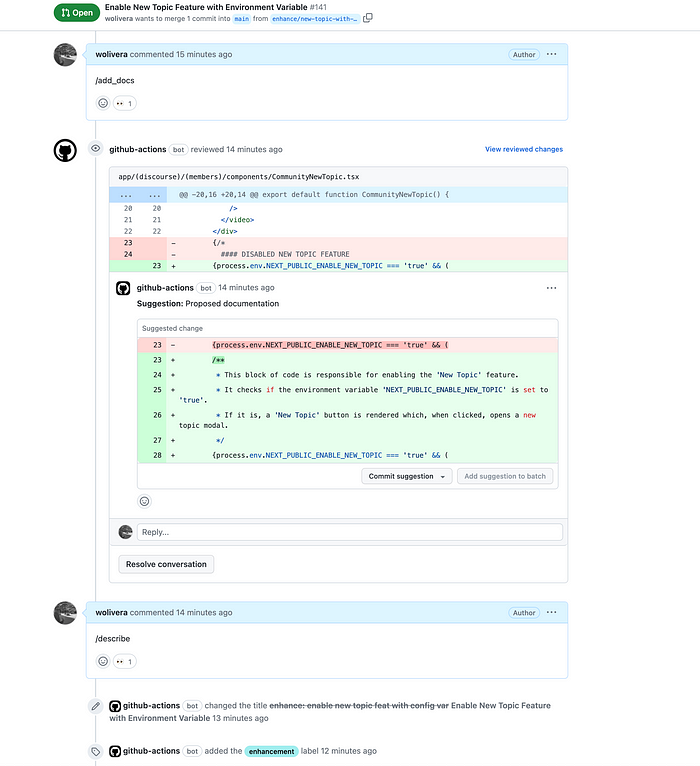
Maintaining high code quality in software development is essential but also challenging. The team is responsible for ensuring that changes over time remain consistent, and one effective way to achieve this is by following the GitFlow model. This way, before a developer can merge a feature, their code must go through a code review process.
Why does code need to be reviewed before merging?
Well, all the code should leave the project in a functional state and follow certain project level standards. Some examples of project level standards include adding the appropriate tests, correctly defining variable types, and having the code logic in the appropriate files/functions.
Typically, this review process is done cross-functionally between peers or by a technical lead with more experience. Conducting a thorough code review requires time and focus to be effective and identify potential improvements. However, as a team grows and the need for rapid changes increases, sufficient time is often not dedicated to reviews.
This is where automated tools leveraging artificial intelligence (AI) for code reviews are gaining popularity due to their ability to provide immediate feedback and suggestions. So this article explores the use of AI code review tools and strategies to control costs and ensure data security.
What advantages can we found with AI code reviews?
It is important to mention that AI-driven reviews do not replace human oversight, and there are often business rules that justify changes. However, it is possible to optimize other general aspects:
- Efficiency: Accelerate the code review process by providing instant feedback.
- Consistency: Ensure a uniform review process by applying the same standards across all code submissions.
- Quality Improvement: Detect potential bugs, code smells, and suggest improvements, enhancing the overall quality of the codebase.
- Interactive Feedback: Facilitate discussions and enables developers to apply suggestions directly.
🤖 CodiumAI PR-Agent
One notable tool in this space is CodiumAI PR-Agent, which is designed to help efficiently review and handle pull requests by providing AI feedback and suggestions. CodiumAI PR-Agent supports various platforms, including GitHub, GitLab, Bitbucket, and Azure DevOps, making it versatile for different development environments.
The agent offers a range of commands to assist in different aspects of code review, such as checking the code, suggesting improvements, answering questions, and updating documentation. This tool exemplifies how AI can streamline the code review process and improve overall code quality.
🖐️ Hands-On Instructions
Prerequisites
Before setting up the CodiumAI PR-Agent, you will need:
- An API key from OpenAI.
- Access to your GitHub repository settings.
Step-by-Step Configuration
Obtain an API Key from OpenAI: Sign up or log in to the OpenAI platform and generate an API key. This key will allow the CodiumAI PR-Agent to access OpenAI’s AI models.
Create a Workflow File:
- In your GitHub repository, navigate to the
.github/workflowsdirectory. If this directory does not exist, create it. - Create a new file named
pr_agent.yml(the file name can be anything, but it should have a.ymlextension).
Add the Configuration:
- Paste the following configuration into the
pr_agent.ymlfile:
name: AI Code Review
on:
pull_request:
issue_comment:
jobs:
pr_agent_job:
runs-on: ubuntu-22.04
permissions:
issues: write
pull-requests: write
contents: write
name: Run PR agent on every pull request, respond to user comments
steps:
- name: PR Agent action step
id: pragent
uses: Codium-ai/[email protected]
env:
OPENAI_KEY: ${{ secrets.OPENAI_KEY }}
GITHUB_TOKEN: ${{ secrets.GITHUB_TOKEN }}
CONFIG.MODEL: "gpt-3.5-turbo"
CONFIG.MAX_MODEL_TOKENS: 16000Explanation of the Configuration:
- name: Defines the name of the workflow as “AI Code Review.”
- on: Specifies the events that trigger the workflow, such as pull requests and issue comments.
- jobs: Contains the details of the job that will run.
- runs-on: Specifies the environment for the job (Ubuntu 22.04 in this case).
- permissions: Grants necessary permissions to the job.
- steps: Details the steps to execute, including using the
pr-agentaction with the specified environment variables.
Set Up Secrets:
- In your GitHub repository, go to
Settings>Secretsand add the following secrets: OPENAI_KEY: Your OpenAI API key.GITHUB_TOKEN: A GitHub token with appropriate permissions (usually provided automatically by GitHub Actions).
🧰 Using the CodiumAI PR-Agent
Once configured, the CodiumAI PR-Agent will automatically analyze pull requests and issue comments, providing feedback and suggestions. This automation helps maintain high code quality and fosters a collaborative development environment.

Example Commands
- /describe: Automatically generates a description for the pull request.
- /review: Provides detailed feedback on the pull request.
- /improve: Suggests improvements to the code.
- /generate_labels: Generates custom labels for the pull request.

💭 Are there alternatives to CodiumAI?
Of course, CodiumAI is just an example but there are alternatives, that overall, work the same way. So when choosing an AI code review tool, consider the following criteria:
Platform Compatibility: Make sure the tool supports the version control systems you use, such as GitHub, GitLab, Bitbucket, or Azure DevOps.
Feature Set: Look for tools that offer comprehensive features such as automated code review, code improvement suggestions, and the ability to ask questions about the code.
Integration Capabilities: The tool should seamlessly integrate with your existing CI/CD pipelines and development workflows.
Model Support: Also check that the tool supports the AI models you prefer, such as GPT-3.5, GPT-4, or other models from providers like Anthropic, Cohere, or Llama.
Customization: Check the tool allows for customization to meet your specific coding standards and guidelines.
💸 Controlling Costs with Paid AI Models
When using AI-powered tools, managing costs is crucial. Various AI providers, including OpenAI, charge based on the number of tokens processed, which includes both the input and output tokens for each API call. Here are some steps to estimate and control these costs:
Understand Token Usage: Each API call processes a number of tokens based on the size of the code being reviewed and the generated response. Larger code changes will use more tokens.
Review Pricing: Check the pricing for different models on the provider’s website. For example, OpenAI’s pricing for models like GPT-3.5 and GPT-4 can be found on the OpenAI pricing page.
Estimate Usage: Calculate the average number of tokens used per review and multiply this by the expected number of reviews per month. For instance, if one review uses 5,000 tokens and you conduct 100 reviews per month, your monthly usage would be 500,000 tokens. Use the cost per token to estimate your monthly expense.
Monitor Usage: Regularly check your usage on the provider’s dashboard to stay informed about your token consumption and adjust your estimates as needed.
Optimize Usage: Use configuration settings to optimize token usage, such as setting limits on response lengths or prioritizing certain types of feedback.
🥷 Privacy and Confidentiality
If privacy and confidentiality are primary concerns, there are alternatives to using cloud-based AI models that can help you be compliant with your project requirements.
Local Deployment: Deploy AI models locally within your organization’s infrastructure. This keeps all data in-house and under your control.
Custom Models: Train custom AI models tailored to your specific needs. This can be done using frameworks like TensorFlow or PyTorch and ensures that the model is optimized for your unique requirements.
Hybrid Approaches: Use a hybrid approach where sensitive data is processed locally, while non-sensitive data can leverage cloud-based models. This balances the benefits of cloud computing with the need for data privacy.
🔐 Ensuring Data Security
In a similar line as with data privacy, data security is also major concern when using AI tools. There are some strategies to ensure the security and confidentiality of the code:
Use of Private Models: Consider using private AI models that do not share data with external providers. Models from companies like Cohere and Anthropic offer options that prioritize data privacy.
Data Encryption: Ensure that data is encrypted during transmission and storage. This adds a layer of protection against unauthorized access.
Access Controls: Implement strict access controls to limit who can use the AI tools and access the reviewed code. This includes using API keys and secret management systems to secure credentials.
Regular Audits: Conduct regular security audits to identify and mitigate potential vulnerabilities in your setup.
💡 Conclusion
Integrating AI-powered code reviews into your development workflow is a strategic move to enhance code quality and efficiency. You can leverage the power of AI to improve your development process while protecting your codebase. Examples like CodiumAI PR-Agent demonstrate the practical application and benefits of this powerful technology.
Explore different hosting options and models to find the best fit for your organization’s needs, and stay vigilant about monitoring and optimizing your AI tool usage to maintain high standards of code quality and security.
Partner with ZirconTech, a leader in leveraging the latest AI tools and technologies to provide optimized services that ensure high code quality and speed. At ZirconTech, we utilize cutting-edge AI-powered code review tools and constantly update our methodologies to deliver efficient, consistent, and high-quality solutions tailored to your development needs. Collaborate with us to enhance your software development process, maintain robust code standards, and accelerate your project timelines. Embrace the future of software development with ZirconTech’s AI-driven innovation.